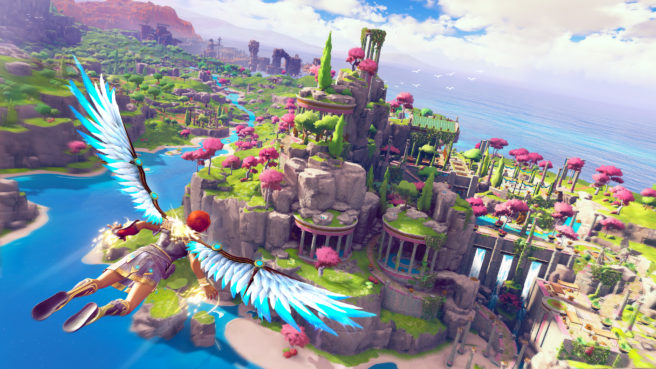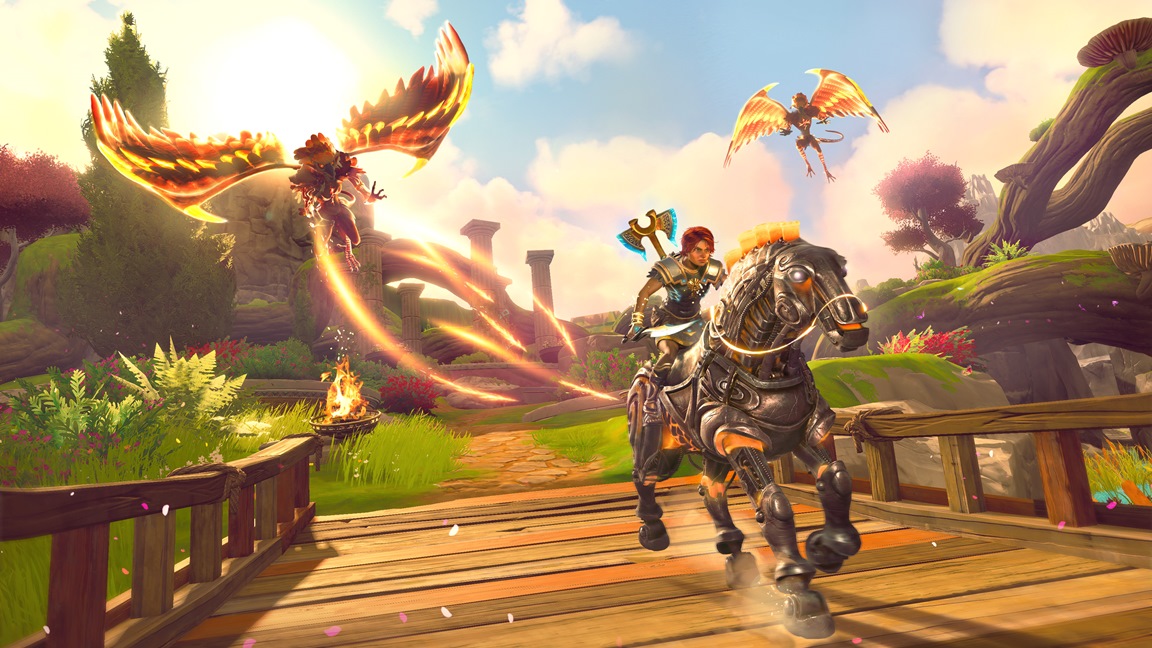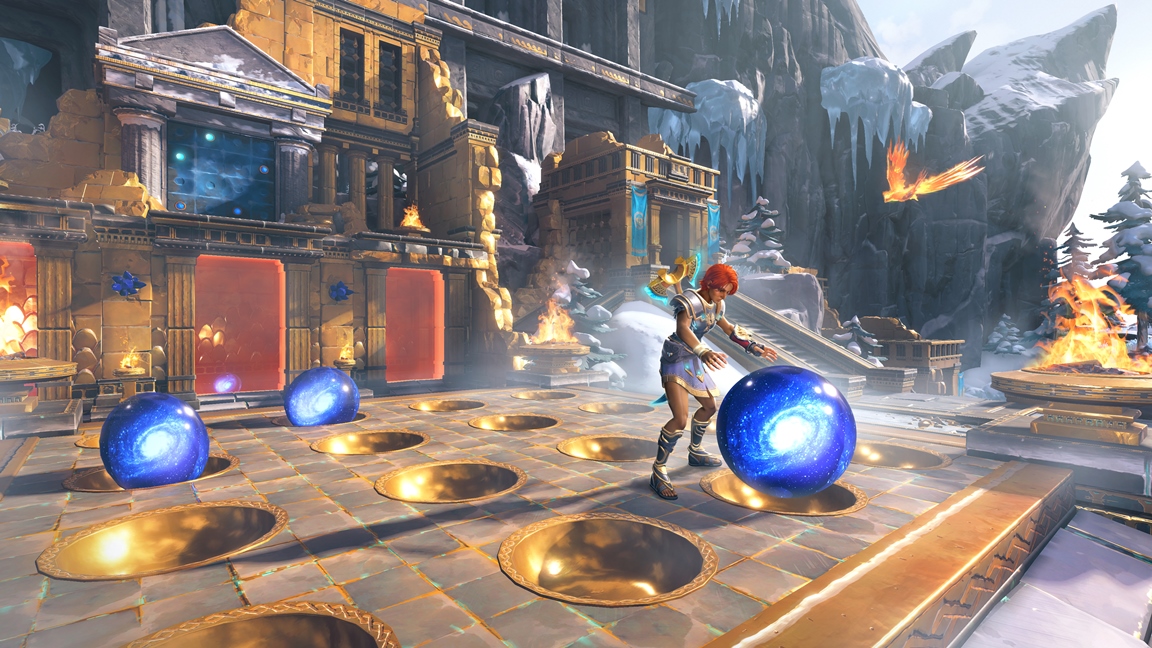Hands on with Immortals Fenyx Rising, formerly known as Gods & Monsters
When Gods & Monsters was initially revealed in 2019 at Ubisoft’s E3 event, it was a title I couldn’t stop thinking about for the duration of the expo and well beyond. As the months passed by though, the radio silence would have me worried. As its initial release window of February 2020 started to approach, it became more apparent with the lack of information that this target wouldn’t be hit, and sure enough we would eventually get confirmation of a delay. The game has now finally resurfaced, and after having spent two hours with it as part of a hands-on event, Gods & Monsters – now known as Immortals Fenyx Rising – has come far since its reveal and may prove to be one of Ubisoft’s most beautiful, magical, and adventurous titles in a very long time.
My two hour demo session with Immortals Fenyx Rising immediately had me in awe as I was greeted by a stunning landscape that placed me about halfway through the game, so I had quite a few abilities unlocked to play around with as well as complete freedom within an area called The Forgelands. Admittedly, it could have been a game in itself with how big it was, yet it was only a fraction of the full map that we’ll see later this holiday season. The Forgelands has more of a rocky, desert landscape, but still provided tons of beautiful stone structures, greenery, dungeons, artifacts, and the like that were all so vibrant despite the typical desolate nature of a more barren environment riddled with dirt and erosion.
The feeling of awe and wonderment never ceased as I continued on with quests, facing unique enemies with a combat system that feels much more fleshed out than your typical Assassin’s Creed experience, though maybe not as accessible as Zelda: Breath of the Wild – a game that some have compared this to. The multitude of abilities you can use and unlock, which help emphasize the mythological portion of ancient Greece, make for a tailored experience consisting of more than just basic hacking and slashing. You can freely use a basic sword and hammer, but abilities are tied to a stamina meter. These include Apollo’s Arrow (an attack that can also be charged and held to guide it as it goes through the air), Hephaestos’s Hammer (which is like a massive special attack), and Athena’s Dash (a move that involves using your shield to ram into enemies). It’s even possible to fly anywhere briefly using stamina. Most things are customizable (even your character’s appearance) and can be transmogrified for further effect as well.
Just about anywhere you go will contain something to explore, look at, and collect, and it does so in a way that feels not only seamless, but thankfully worthwhile. I was almost always finding some sort of better armor or useful trinkets and items that rewarded my efforts in facing a wave of enemies, a mini-boss, or successfully completing a puzzle hidden deep beneath a mountain that made the exploration and curiosity feel natural rather than an obstruction. I feel there are way too many open world games that place fluff in an open world to have something to do with no real substance, so thankfully there’s inspiration here outside of its initial art direction from Breath of the Wild here that was thought of as to make every little nook and cranny continue to give off that sense of a journey and adventure that would remain memorable and something worth talking about.
One of Breath of the Wild’s greatest qualities was the fact that – even in the more open and serene areas where there’s not much going on – there was something to see and experience in every corner. Every area had its own story, backstory, environmental storytelling and the like that not only kept the player curious to uncover more, but would make talking about the game even more fun when with peers, friends, and family. It’s why that game to this day still continues to see so many tweets with people continuing to uncover and try out new things, playing around with the game’s mechanics which also become a part of the game worth talking about. Assassin’s Creed Odyssey – developed by the same team as Immortals Fenyx Rising – had this to a degree as well, but its biggest drawback, interestingly, was that the world was too big with a whole lot of nothing in between. It could take what felt like ages to walk from one area to another, or even while on a boat going to other islands. While most areas of Assassin’s Creed Odyssey were absolutely stunning, the large open lands in between never really offered much outside of a few chests you may find to get lucky enough to transmog something or to sell, but even something like that tends to get old after a while and is ultimately there for those that like to “clean up” a map. In contrast, Immortals Fenyx Rising in my playthrough made every moment count, and rather than avoiding battles like I would do in some games because they would feel like an obstruction (especially the ones that lock you into it), I was always excited to go into them.
The art direction has slightly changed from its initial reveal, and while it still has that sort of family-friendly animated charm to it, it’s definitely a little more mature – something akin to Star Wars: The Clone Wars, or even Ubisoft’s own Starlink: Battle for Atlus. In addition to the sense of adventure and wonderment you get from the moment you pick up the controller, the colors and art direction truly help to complement the entire experience and really brings the Greek mythology to life in a really beautiful and unique way. You still have that sort of cel-shaded-esque approach to some of the environment (particularly the grass), but it’s not as heavy this time around. However, it’s also not trying to go for the more realistic approach. The direction and craft behind Immortals Fenyx Rising feels unique and special, blending not only the styles and history of a few different things, but creating something new out of it as well.
Immortals Fenyx Rising releases on December 3 on all platforms including Switch, and based on what I’ve played, I’m immensely excited for the full release. We’ll have to wait to see how the full experience turns out, but so far it has a promising open world that will hopefully give players on Nintendo’s console a truly beautiful and meaningful experience they can get lost in. My biggest concern is that the graphics have improved significantly, and during my time with it on an early build on PC and an Xbox controller, it’s clear that the game has come a long way – almost impressively so – since its initial announcement. With how detailed and vast the world is, it’ll truly be a technical feat to see it running on what is essentially mobile hardware on Switch. Ubisoft has had a really good track record on the system with large titles like Assassin’s Creed III, Rogue, and Black Flag as well as the aforementioned Starlink: Battle for Atlus, which was tremendous and vast in its own right, so hopefully they’re putting a lot of time and care into making it contain as much parity as possible between all platforms.
So far, Immortals Fenyx Rising seems stunning, the puzzles are clever and creative, and the protagonist, while she didn’t say much in my playthrough, is appealing and likable. Other elements such as the menus, user interface, skill trees, and HUD from what I’ve played felt carefully packaged, thought out, and intuitive. If everything comes together, this could easily be a top contender for me of games to get and recommend as we get closer to release. Immortals Fenyx Rising has the potential to please a wide demographic of players, and in the Switch’s case could become one of the most memorable titles on the hybrid system.



